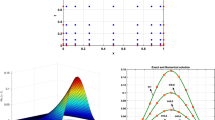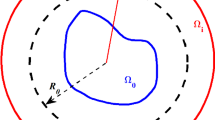Abstract
This paper presents two models for hepatitis B, both given by fractional differential equations. The first model is formulated without parameters that indicate drug therapy, while the second one considers the drug therapy. The basic reproduction number and the stability analysis are considered for both models. Moreover, some numerical simulations by nonstandard finite difference schemes are presented. The numerical results show that the solutions converges to an equilibrium point as predicted in the stability analysis.




Similar content being viewed by others
Notes
Note that, from Definition 2, that \(I^\alpha t^\beta =t^{\beta +\alpha }\Gamma (\beta +1)/\Gamma (\beta +\alpha +1),\) i.e., the polynomial case is a recovered if \(\alpha ,\beta \in \mathbb {N}\).
This fact is one of the main differences between the fractional derivatives of Camargo and de Oliveira (2015).
As made in Driessche and Watmough (2002) the basic reproduction number will be the biggest eigenvalue of K. For convenience, we omit the square root.
References
Ahmed E, El-Sayed AMA, El-Saka HAA (2007) Equilibrium points, stability and numerical solutions of fractional order predator–prey and rabies models. J Math Anal Appl 325:542–553
Arafa AAM, Hanafy IM, Gouda MI (2016) Stability analysis of fractional order HIV infection of \(^+\)T cells with numerical solutions. J Fract Calc Appl 7(1):36–45
Camargo RF, de Oliveira EC (2015) Cálculo fracionário. Editora Livraria da Física, São Paulo, Brasil
Cardoso LC, dos Santos FLP, Camargo RF (2017) Método de diferenças finitas não clássico aplicado ao cálculo fracionário. Revista Eletrônica Paulista de Matemática 7:45–54
Ciupe SM et al (2007) The role of cells refractory to productive infection in acute hepatitis B viral dynamics. PNAS 12:5050–5055
Debnath E (2003) Recent applications of fractional calculus to science and engineering. Int J Math 2003:3413–3442
Degertekin B, Lok Anna SF (2009) Indications for therapy in hepatitis B. Hepatology 49:129–137
Diekmann O, Heesterbeek AP, Roberts GM (2009) The construction of next-generation matrices for compartmental epidemic models. J R Soc Interface 7:873–885
Diethelm K (2004) The analysis of fractional differential equations. Notes in mathematics Springer, Germany
Diethelm K, Ford NJ, Freed AD, Luchko Yu (2005) Algorithms for the fractional calculus selection of numerical methods. Comput Methods Appl Mech Eng 194:743–773
Dietz H (1983) The estimation of the basic reproduction number for infectious diseases. Stat Methods Med Res 2:23–41
Dokoumetzidis A, Magin R, Macheareas P (2010) Fractional kinetics in multi-compartmental systems. J Pharmacokinet Pharmacodyn 37:507–524
Ferreira MS (2000) Diagnóstico e tratamento da hepatite B. Revista da Sociedade Brasileira de Medicina Tropical 33:389–400
Forde JE, Ciupe SM, Arias AC, Lenhart S (2016) Optimal control of drug therapy in a hepatitis B model. Appl Sci 6:1–18
Gómez JF, Rosales JJ, Bernal JJ, Guía M (2012) Mathematical modelling of the mass-spring-damper system–a fractional calculus approach. Acta Universitaria 5:5–11
Kuroda LKB, Gomes AV, Tavoni R, Mancera Paulo FA, Valralta N, Camargo RF (2017) Unexpected behavior of Caputo fractional derivative. Comput Appl Math 136:1173–1183
Lewin SR, Ribeiro RM, Walters T, Lau GK (2001) Analysis of hepatitis B viral load decline under potent therapy: complex decay profiles observed. Hepatology 34:1012–1019
Machado JAT (2003) A probabilistic interpretation of the fractional-order differentiation. Fract Calc Appl Anal 6:73–80
Matignon D (1996) Stability result on fractional differential equations with applications to control processing. In: IMACS-SMC proceedings, pp 963–968
McCallemail JP, David KW (2009) Learning and memory in disease vectors. Trends Parasitol 18:429–433
Mickens R, Smith A (1990) Finite-difference models of ordinary differential equations: influence of denominator functions. J Frankl Inst 327:143–149
Nowak M, Bonhoeffer S, Hill A, Boehme R, Thomas HC, McDade H (1996) Viral dynamics in hepatitis B virus infection. Proc Natl Acad Sci 93:4398–4402
Odibat ZM, Shawagfeh NT (2007) Generalized Taylor’s formula. Appl Math Comput 186:286–293
Okyene E, Oduro FT (2016) Fractional order SIR model with constant populations. BIMCS 14:1–12
Ongun MY, Arslan D, Garrappa R (2013) Nonstandard finite difference schemes for a fractional order Brusselator system. Adv Differ Equ 102:1–11
Ortigueira MD, Machado JAT (2015) What is a fractional derivative? J Comput Phys 293:4–13
Podlubny I (1999) Fractional differential equations, mathematics in science and engineering. Academic Press, San Diego
Podlubny I (2002) Geometric and physical interpretation of fractional integration and fractional differentiation. Fract Calc Appl Anal 5(4):367–386
Salman MS, Yousef AM (2017) On a fractional-order model for HBV infection with cure of infected cells. J Egypt Math Soc 2:1–7
Tumwiine J (2007) A mathematical model for the dynamics of malaria in a human host and mosquito vector with temporary immunity. Appl Math Comput 4:1954–1965
van den Driessche P, Watmough J (2002) Reproduction numbers and subthreshold endemic equilibria for compartmental models of disease transmission. Math Biosci 180:29–48
Varalta N, Gomes AV, Camargo RF (2014) A prelude to the fractional calculus applied to tumor dynamic. TEMA 15:7–14
Zhou X, Sun Q (2014) Stability analysis of a fractional-order HBV infection model. Int J Adv Appl Math Mech 2:1–6
Acknowledgements
LCC thanks CAPES, and RFC thanks CNPq (universal 455920-2014-1) for financial support. The authors thanks the research group CF@FC for the important and productive discussion.
Author information
Authors and Affiliations
Corresponding author
Additional information
Communicated by José Tenreiro Machado.
L. C. Cardoso is supported by NSF Grant CAPES - 1515153.
Rights and permissions
About this article
Cite this article
Cardoso, L.C., Dos Santos, F.L.P. & Camargo, R.F. Analysis of fractional-order models for hepatitis B. Comp. Appl. Math. 37, 4570–4586 (2018). https://doi.org/10.1007/s40314-018-0588-4
Received:
Revised:
Accepted:
Published:
Issue Date:
DOI: https://doi.org/10.1007/s40314-018-0588-4




